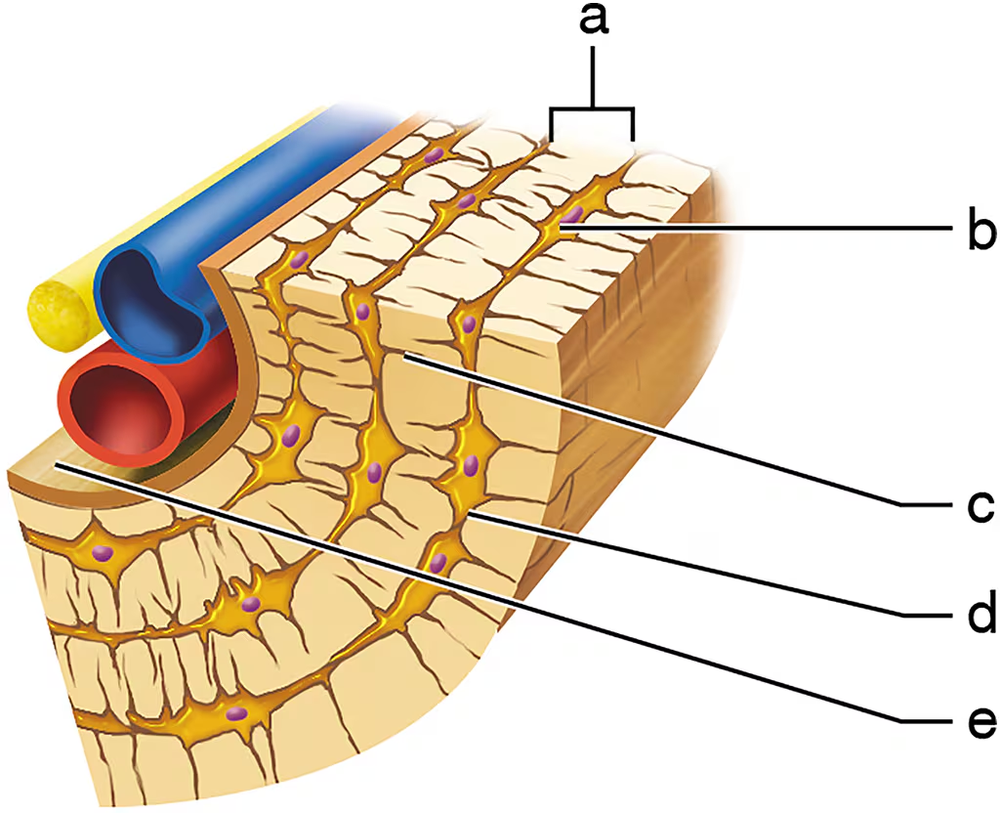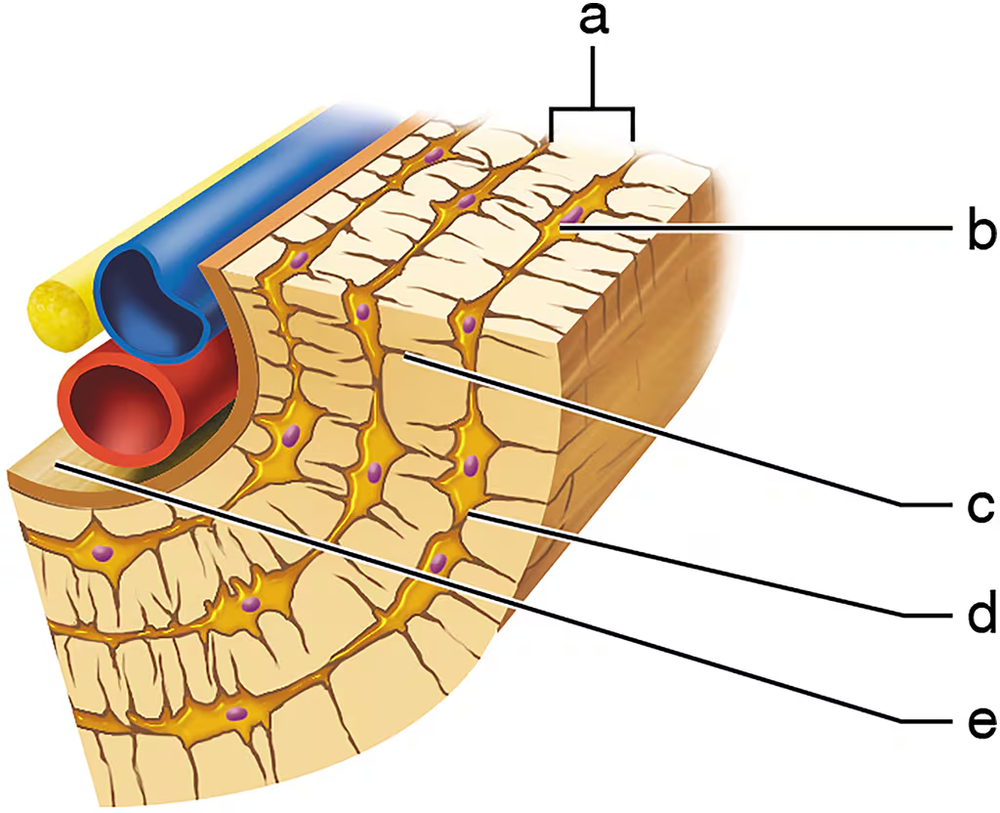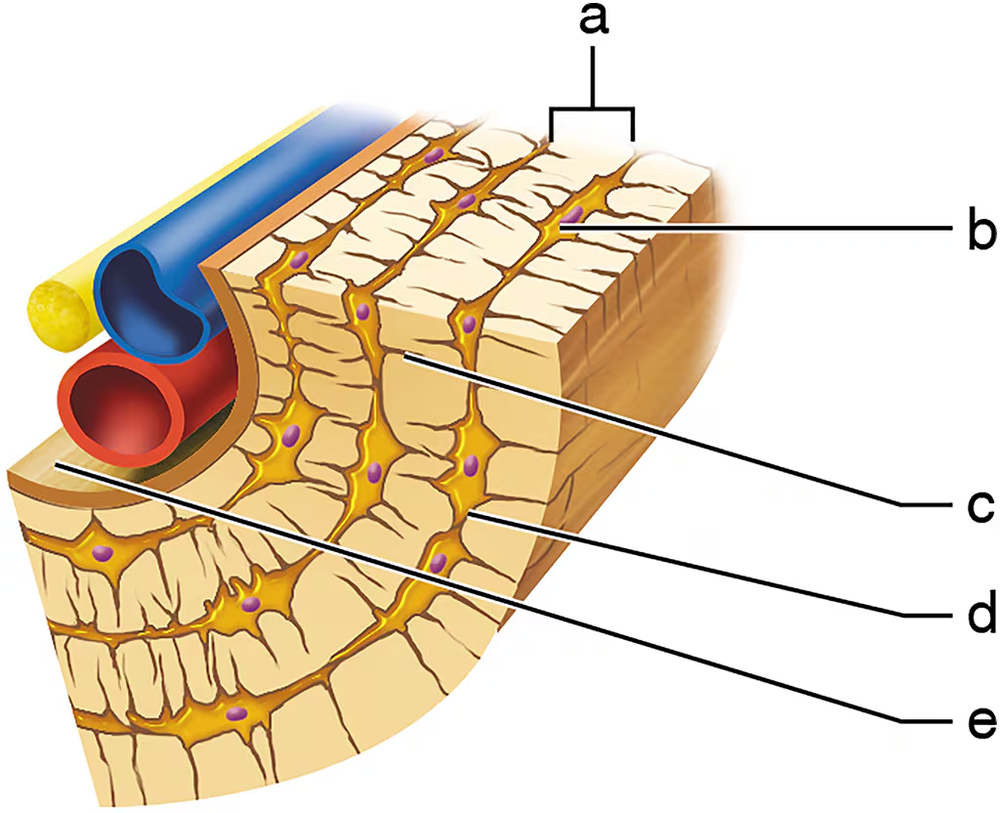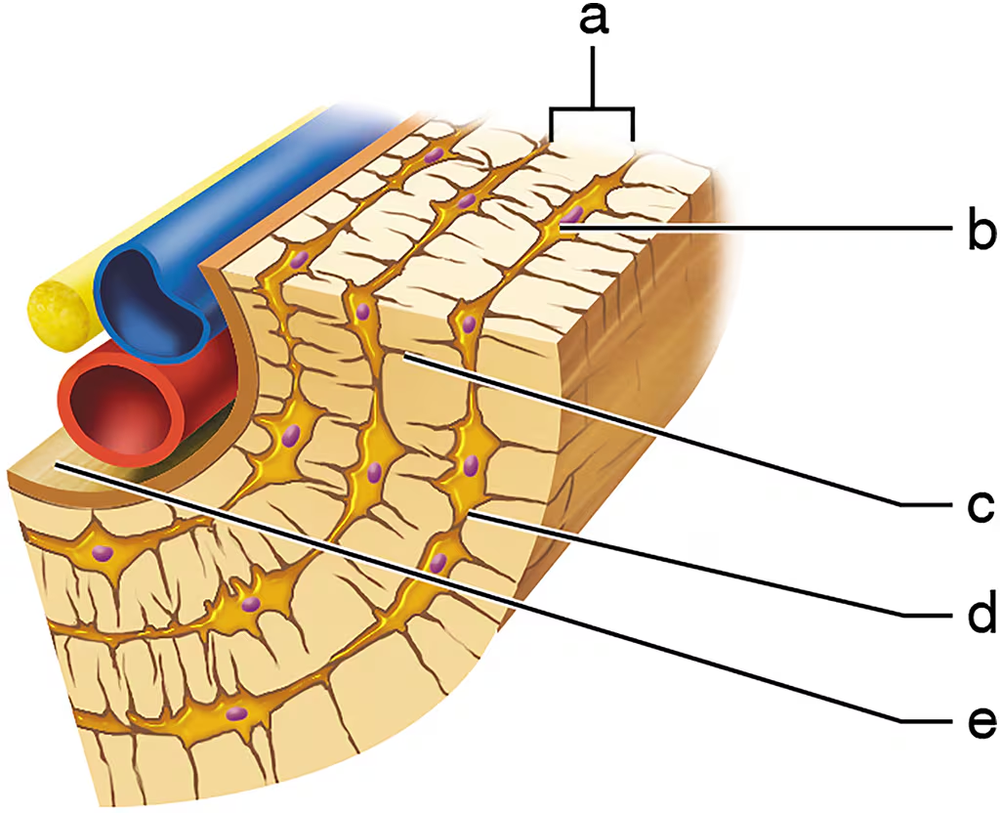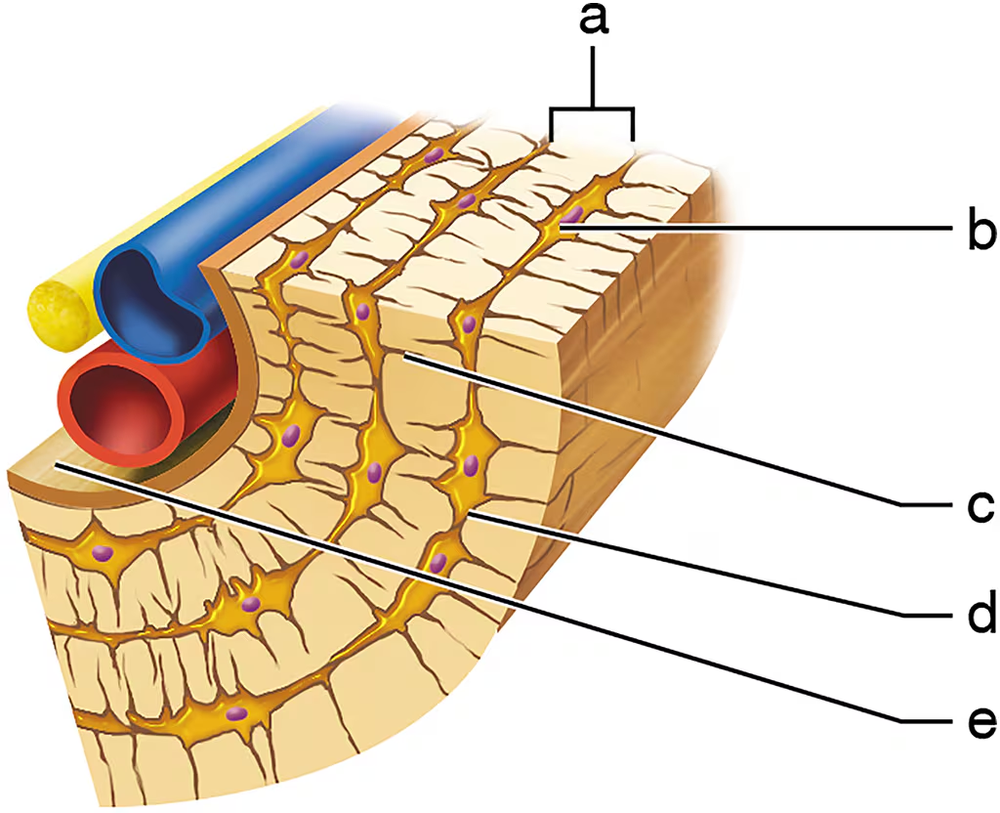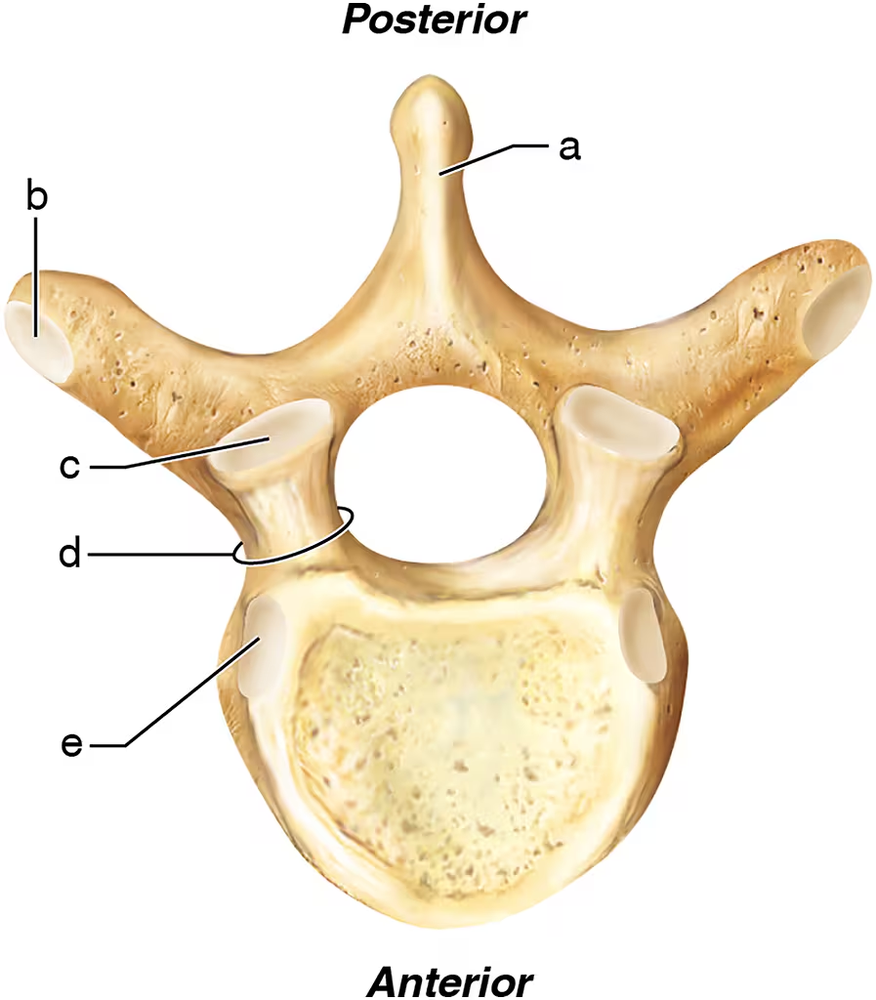 Back
BackProblem 1
Which of the following are correctly matched?
a. Short bone—wrist
b. Long bone—leg
c. Irregular bone—sternum
d. Flat bone—cranium
Problem 2a
Match the appropriate name with the structure in the figure.
1. Central canal
Problem 2b
Match the appropriate name with the structure in the figure.
2. Lamella
Problem 2c
Match the appropriate name with the structure in the figure.
3. Lacuna
Problem 2d
Match the appropriate name with the structure in the figure.
4. Canaliculus
Problem 2e
Match the appropriate name with the structure in the figure.
5. Osteocyte
Problem 3
Which of the following would you expect to be prominent in osteoclasts?
a. Golgi apparatus
b. Lysosomes
c. Microfilaments
d. Exocytosis
Problem 5
Bones that articulate with the sphenoid include which of the following?
a. Parietal
b. Frontal
c. Occipital
d. Zygomatic
e. Ethmoid
Problem 6
Which humeral process articulates with the radius?
a. Trochlea
b. Greater tubercle
c. Lesser tubercle
d. Capitulum
e. Olecranon fossa
Problem 7
Which parts of the thoracic vertebrae articulate with the ribs?
Problem 8
Which of the following bones or bone parts articulate with the femur?
a. Ischial tuberosity
b. Pubis
c. Patella
d. Fibula
e. Tibia
Problem 9
Which bone of the arm corresponds to the femur of the leg?
a. Ulna
b. Humerus
c. Radius
d. Tibia
e. Fibula
Problem 10
At what stage of life do the lower limbs attain the same height as the head and trunk?
a. At birth
b. By 10 years of age
c. At puberty
d. When the epiphyseal plates fuse
e. Never
Problem 11a
Match the types of joints to the descriptions that apply to them. (More than one description might apply.)
a. Fibrous joints
b. Cartilaginous joints
c. Synovial joints
1. Have no joint cavity
Problem 11b
Match the types of joints to the descriptions that apply to them.
a. Fibrous joints
b. Cartilaginous joints
c. Synovial joints
2. Types are sutures and syndesmoses
Problem 11c
Match the types of joints to the descriptions that apply to them.
a. Fibrous joints
b. Cartilaginous joints
c. Synovial joints
3. Dense connective tissue fills the space between the bones
Problem 11e
Match the types of joints to the descriptions that apply to them.
a. Fibrous joints
b. Cartilaginous joints
c. Synovial joints
4. Almost all joints of the skull
Problem 11f
Match the types of joints to the descriptions that apply to them.
a. Fibrous joints
b. Cartilaginous joints
c. Synovial joints
6. All are diarthroses
Problem 11g
Match the types of joints to the descriptions that apply to them.
a. Fibrous joints
b. Cartilaginous joints
c. Synovial joints
7. The most common type of joint in the body
Problem 11h
Match the types of joints to the descriptions that apply to them.
a. Fibrous joints
b. Cartilaginous joints
c. Synovial joints
8. Nearly all are synarthrotic
Problem 11i
Match the types of joints to the descriptions that apply to them.
a. Fibrous joints
b. Cartilaginous joints
c. Synovial joints
9. Shoulder, hip, knee, and elbow joints
Problem 12a
Match the bone markings listed on the right with their function listed on the left.
1. Attachment site for muscle or ligament
2. Forms a joint surface
3. Passageway for vessels or nerves
a. Trochanter
Problem 12b
Match the bone markings listed on the right with their function listed on the left.
1. Attachment site for muscle or ligament
2. Forms a joint surface
3. Passageway for vessels or nerves
b. Condyle
Problem 12c
Match the bone markings listed on the right with their function listed on the left.
1. Attachment site for muscle or ligament
2. Forms a joint surface
3. Passageway for vessels or nerves
c. Foramen
Problem 12d
Match the bone markings listed on the right with their function listed on the left.
1. Attachment site for muscle or ligament
2. Forms a joint surface
3. Passageway for vessels or nerves
d. Process
Problem 12e
Match the bone markings listed on the right with their function listed on the left.
1. Attachment site for muscle or ligament
2. Forms a joint surface
3. Passageway for vessels or nerves
e. Facet
Problem 12f
Match the bone markings listed on the right with their function listed on the left.
1. Attachment site for muscle or ligament
2. Forms a joint surface
3. Passageway for vessels or nerves
f. Tuberosity
Problem 13
What is yellow marrow? How do spongy and compact bone look different?
Problem 14
Name the eight bones of the cranium.
Problem 15
What facial bone forms the chin? The cheekbone? The upper jaw? The bony eyebrow ridges?

